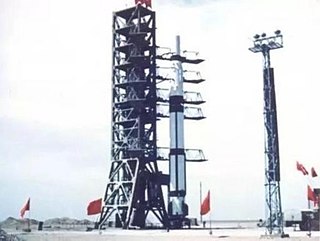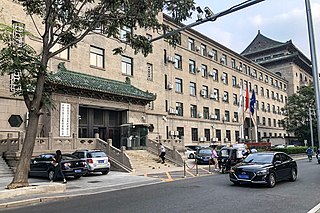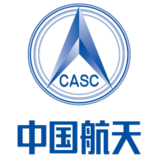
The space program of the People's Republic of China is about the activities in outer space conducted and directed by the People's Republic of China. The roots of the Chinese space program trace back to the 1950s, when, with the help of the newly allied Soviet Union, China began development of its first ballistic missile and rocket programs in response to the perceived American threats. Driven by the successes of Soviet Sputnik 1 and American Explorer 1 satellite launches in 1957 and 1958 respectively, China would launch its first satellite, Dong Fang Hong 1 in April 1970 aboard a Long March 1 rocket, making it the fifth nation to place a satellite in orbit.

The China National Space Administration (CNSA) is a government agency of the People's Republic of China headquartered in Haidian, Beijing, responsible for civil space administration and international space cooperation. These responsibilities include organizing or leading foreign exchanges and cooperation in the aerospace field. The CNSA is an administrative agency under the Ministry of Industry and Information Technology.

China North Industries Group Corporation Limited, doing business internationally as Norinco Group, and known within China as China Ordnance Industries Group Corporation Limited, is a Chinese state-owned defense corporation that manufactures commercial and military products. Norinco Group is one of the world's largest defense contractors.
The China Academy of Space Technology (CAST) is a Chinese space agency and subordinate of China Aerospace Science and Technology Corporation (CASC). The agency was founded on 20 February 1968, and is the main spacecraft development and production facility in China. On 24 April 1970, CAST successfully launched China's first artificial satellite Dong Fang Hong I.

China National Aero-Technology Import & Export Corporation is a Chinese state-owned defense company with a core business in aviation products and technology. It is the exclusive representative of the Aviation Industry Corporation of China (AVIC) in the global market.
China Aerospace International Holdings Limited is a Hong Kong incorporated holding company. The company itself is a subsidiary of China Aerospace Science and Technology Corporation and a listed company on the Stock Exchange of Hong Kong. It is a red chip company, but not part of the "red chip index" of the stock exchange.
Sino Satellite Communications Co., Ltd. known also as SinoSat is a Chinese company.
Wanhua Industrial Group Co., Ltd. is a Chinese holding company. It was the parent company of Wanhua Chemical Group and BorsodChem until 2018. Yantai Municipal People's Government, via Yantai Guofeng, still owned 39.497% stake of the company as of 2017. The government also sold 25% stake of the company to a consortium of Pemex and Deutsche Bank in 2007.

Ma Xingrui is a Chinese politician and aerospace engineer who is the Communist Party secretary of Xinjiang. Prior to that, he had served as the Vice Minister of Industry and Information Technology, Head of the Political and Legal Affairs Commission of Guangdong, Communist Party Secretary of Shenzhen, Deputy Party Secretary of Guangdong, and Governor of Guangdong. Ma is a member of the Politburo of the Chinese Communist Party.

APT Satellite Holdings Limited is a Bermuda-incorporated holding company. Its Hong Kong-incorporated subsidiary APT Satellite Co., Ltd. is the operator of the Apstar satellite constellation. APT Satellite Holdings and APT Satellite are headquartered in Hong Kong.
Xinjiang Ba Yi Iron and Steel Co., Ltd. known as Ba Yi Iron & Steel or 8 1 Iron & Steel or August 1 Iron & Steel or BYIS or Bagang or Basteel, is a Chinese steel maker based in Ürümqi, Xinjiang. The company was a second-tier subsidiary of China Baowu Steel Group, via Ba Yi Iron and Steel Group. The rest of the shares of the company float in Shanghai Stock Exchange. Xinjiang government is the minority shareholder of the holding company: Ba Yi Iron and Steel Group.

Tianjin Pipe (Group) Corporation Limited known as Tianjin Pipe or its abbreviation TPCO, is the largest stemless steel pipe maker of China as well as one of the largest in the world.

CRRC Group Corporation, known as CRRC Group, is a Chinese state-owned holding company, direct parent company of CRRC and 32 other subsidiaries; if including second-tier subsidiaries, the holding company is the head of 112 legal entities.

China Energine International (Holdings) Limited, or China Energine, is a Hong Kong-based and Cayman Islands-incorporated holding company. The controlling shareholder was Chinese state-owned mega-conglomerate China Aerospace Science and Technology Corporation (CASC). The company was formerly known as CASIL Telecommunications Holdings Limited; CASIL was an acronym of China Aerospace International Holdings Limited, a listed subsidiary of CASC.
China Satellite Communications Co., Ltd. known as China Satcom is a Chinese aerospace company that provides services via satellites. The company was a subsidiary of China Aerospace Science and Technology Corporation (CASC).

The Ministry of Astronautics Industry of the People's Republic of China was a ministry of the government of the People's Republic of China which is responsible for the management of research, design and production of rockets, missiles and spacecraft. The ministry was headquartered in Beijing. It existed from 1988 to 1993.
Tiantong is China's first mobile communications satellite system. The first satellite Tiantong-1-01 was launched on August 6, 2016 (UTC+8).
China Academy of Aerospace Aerodynamics or CAAA is a research and manufacturing organization for rockets, missiles and unmanned aerial vehicles (UAVs). Headquartered in Beijing, China, it is a subsidiary of China Aerospace Science and Technology Corporation (CASC).
Zhang Zhongyang is a Chinese executive and politician, currently serving as general manager of the China Aerospace Science and Technology Corporation.
Lei Fanpei is a Chinese executive and politician who served as chairman of the board of China Shipbuilding Group from 2018 to 2022. Previously he served as chairman of the board of China Aerospace Science and Technology Corporation.











